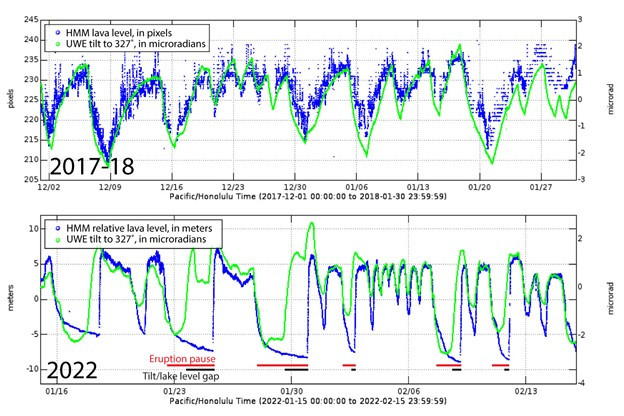A TEMPORARY JONES ACT WAIVER IS SUPPORTED BY ADVOCATES IN GUAM AND HAWAI'I. Guam, like Hawai'i, has been dependent on foreign oil because of the cost of the Jones Act requirement for any oil and other goods from the U.S. mainland to arrive on U.S. carriers, built, owned and largely staffed by U.S. citizens - the cost much higher than using foreign flagged ships.
As a result, about a quarter to a third of oil shipped to Hawai'i has come from Russia on foreign ships. However, the only refinery in Hawai'i vowed to reject Russian oil, likely leading to higher gasoline and electricity costs.
U.S Congressman Rep. Ed Case said he is working on a Jones Act waiver in Washington, D.C. He said, “We’ve never found ourselves in a situation like this,” with the cost of Hawai'i oil likely to soar with the expense of bringing it from the mainland. Case has authored numerous measures to reform the Jones Act, arguing that is responsible for much of the high cost of living in Hawai'i.
 |
| Guamanian Jesse Lujon writes of Guam and Hawai'i both needing a waiver from the Jones Act to combat cost of oil. |
Legislature, wrote an opinion piece in Guam's Pacific Daily News on Sunday. It mirrors concerns in Hawai'i: "The Russian invasion of Ukraine is a new and painful challenge to navigate in our effort to move past the economic turmoil the pandemic has heaped on our island. The invasion is very likely to cause already sky-high gas prices to increase, making it even more expensive for Guamanians to drive anywhere. Another effect of the invasion might be the rising cost of electricity.....It may even cause the price of airline tickets to increase, which comes at a time when we desperately need tourists to return to Guam."
Lujon wrote that "it is imperative for us to understand that since we import almost everything we need to survive, a temporary waiver of the Jones Act is more relevant and justifiable now than ever before."
Another Jones Act opposition advocate, Grassroot Institute of Hawai'i leader Keli'i Akina, who also serves on the board of Office of Hawaiian Affairs, wrote a letter to Pres. Joe Biden this week asking for the waiver. See more on the effect of the war in Ukraine on Hawai'i in the Thursday Ka'u News Briefs at http://kaunewsbriefs.blogspot.com/2022_03_03_archive.html
She said that states, school districts, and other education stakeholders "face tremendous challenges to getting students back on track after the challenges they faced during the last two years, and it is critical that we provide them with all available resources."
Regarding reporting disaggregated data on Asian American and Pacific Islander communities, she said this would allow policymakers the opportunity to better understand how students from different sub-populations have been affected by these learning disruptions.
Hirono has advocated for federal funding to support K-12 students, including through the Coronavirus Aid, Relief, and Economic Security Act (CARES Act), Coronavirus Response and Relief Supplemental Appropriations Act (CRRSAA), and American Rescue Plan Act (ARPA), which have collectively provided $200 billion in funding for states, school districts, and K-12 schools to support these students. Last March, ARPA provided $100 million for IES to research and address learning loss in K-12 students, as well as additional funding to support low-income students, students of color, children with disabilities, English learners, migrant students, students experiencing homelessness, and children in foster care.
stakeholders.
When lava began erupting from fissures in Leilani Estates in 2018, Kīlauea’s summit reservoir system began to deflate, and the lava lake quickly drained away before the summit began to collapse.
One of the interesting facets of the 2008–2018 lava lake era was the close association between summit tilt data and the surface level of the lava lake. As the lake surface would rise within the Overlook crater, summit tiltmeters would record inflationary tilt. As the lava lake surface withdrew, tiltmeters would record deflationary tilt.

This unique behavior made it possible to determine certain quantities for the HMM magma reservoir that are difficult or impossible to determine at other volcanoes. For example, it is easier to track magma chamber volume changes than to determine the overall volume, but the open nature of the 2008–2018 lava lake also made this calculation possible.
 |
| A daytime view of the lava lake at Halema'uma'u on Feb. 2, with Mauna Loa looming in the background. USGS photo by F. Trusdell |
In a 2019 publication, scientists showed that by tracking deformation and lava level changes during the opening stages of Kīlauea’s 2018 summit collapses, it was possible to determine that the entire 2018 collapse and eruption decreased the HMM magma reservoir volume by a most likely amount of 20%, leaving the majority of the magma in place.
The current lava lake in Halemaʻumaʻu also rises and falls together with inflationary and deflationary tilt. This indicates that, to some extent, there is again an open connection to the shallow HMM magma chamber. However, some of the deflation and inflation cycles are larger than others, and during these episodes the lava lake level goes down and the eruption pauses. The eruption doesn’t resume, and the lake level doesn’t rise again at the same time as the tiltmeters show inflationary tilt, but instead waits until the amount of inflationary tilt is about equal to the amount of preceding deflationary tilt.
As the February 3rd Volcano Watch stated, this gives us a rough idea of when the eruption pause might be over and active lava will return to the crater, allowing for an amount of forecasting that isn’t usually possible. The gap in time between the return of inflationary tilt and eruption renewal is also an indication that the connection between the surface and shallow HMM reservoir isn’t always open. While the summit is inflating, pressure is building in the reservoir, and it isn’t until the eruption starts again that the pressure is released. After this the system equilibrates and once again behaves as an open system, like it did in 2008–2018.
The current overall trend of Kīlauea’s summit magma system is slow deflation. This means there are no signs right now that the eruption could get more vigorous, and this regime of intermittent pauses and renewals could continue for a while. Without any changes, there may even be a time when there isn’t enough pressure left to drive the current eruption. However, Kīlauea Volcano rarely goes without change for long, so we will be sure to stay attentive and prepared for the unexpected.
 |
| See March edition of The Kaʻū Calendar newspaper at www.kaucalendar.com |




